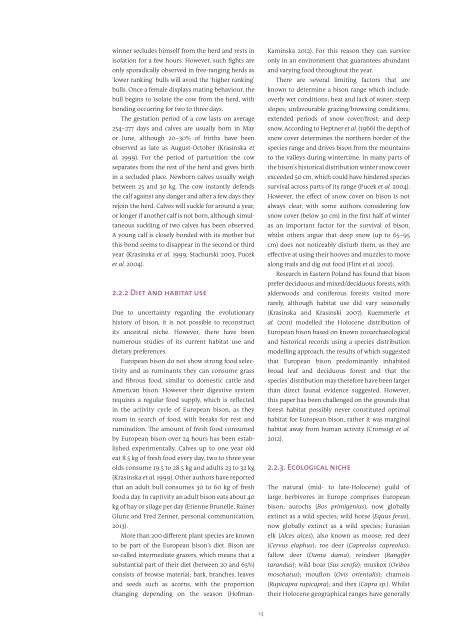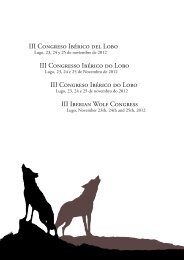Bison-Rewilding-Plan-2014
Bison-Rewilding-Plan-2014
Bison-Rewilding-Plan-2014
- No tags were found...
You also want an ePaper? Increase the reach of your titles
YUMPU automatically turns print PDFs into web optimized ePapers that Google loves.
winner secludes himself from the herd and rests inisolation for a few hours. However, such fights areonly sporadically observed in free-ranging herds as‘lower ranking’ bulls will avoid the ‘higher ranking’bulls. Once a female displays mating behaviour, thebull begins to isolate the cow from the herd, withbonding occurring for two to three days.The gestation period of a cow lasts on average254–277 days and calves are usually born in Mayor June, although 20–30% of births have beenobserved as late as August-October (Krasinska etal. 1999). For the period of parturition the cowseparates from the rest of the herd and gives birthin a secluded place. Newborn calves usually weighbetween 25 and 30 kg. The cow instantly defendsthe calf against any danger and after a few days theyrejoin the herd. Calves will suckle for around a year,or longer if another calf is not born, although simultaneoussuckling of two calves has been observed.A young calf is closely bonded with its mother butthis bond seems to disappear in the second or thirdyear (Krasinska et al. 1999, Stachurski 2003, Puceket al. 2004).2.2.2 Diet and habitat useDue to uncertainty regarding the evolutionaryhistory of bison, it is not possible to reconstructits ancestral niche. However, there have beennumerous studies of its current habitat use anddietary preferences.European bison do not show strong food selectivityand as ruminants they can consume grassand fibrous food, similar to domestic cattle andAmerican bison. However their digestive systemrequires a regular food supply, which is reflectedin the activity cycle of European bison, as theyroam in search of food, with breaks for rest andrumination. The amount of fresh food consumedby European bison over 24 hours has been establishedexperimentally. Calves up to one year oldeat 8.5 kg of fresh food every day, two to three yearolds consume 19.5 to 28.5 kg and adults 23 to 32 kg(Krasinska et al. 1999). Other authors have reportedthat an adult bull consumes 30 to 60 kg of freshfood a day. In captivity an adult bison eats about 40kg of hay or silage per day (Etienne Brunelle, RainerGlunz and Fred Zenner, personal communication,2013).More than 200 different plant species are knownto be part of the European bison’s diet. <strong>Bison</strong> areso-called intermediate grazers, which means that asubstantial part of their diet (between 20 and 65%)consists of browse material; bark, branches, leavesand seeds such as acorns, with the proportionchanging depending on the season (Hofman-Kaminska 2012). For this reason they can surviveonly in an environment that guarantees abundantand varying food throughout the year.There are several limiting factors that areknown to determine a bison range which include:overly wet conditions; heat and lack of water; steepslopes; unfavourable grazing/browsing conditions;extended periods of snow cover/frost; and deepsnow. According to Heptner et al. (1966) the depth ofsnow cover determines the northern border of thespecies range and drives bison from the mountainsto the valleys during wintertime. In many parts ofthe bison’s historical distribution winter snow coverexceeded 50 cm, which could have hindered speciessurvival across parts of its range (Pucek et al. 2004).However, the effect of snow cover on bison is notalways clear, with some authors considering lowsnow cover (below 30 cm) in the first half of winteras an important factor for the survival of bison,whilst others argue that deep snow (up to 65–95cm) does not noticeably disturb them, as they areeffective at using their hooves and muzzles to movealong trails and dig out food (Flint et al. 2002).Research in Eastern Poland has found that bisonprefer deciduous and mixed/deciduous forests, withalderwoods and coniferous forests visited morerarely, although habitat use did vary seasonally(Krasinska and Krasinski 2007). Kuemmerle etal. (2011) modelled the Holocene distribution ofEuropean bison based on known zooarchaeologicaland historical records using a species distributionmodelling approach, the results of which suggestedthat European bison predominantly inhabitedbroad leaf and deciduous forest and that thespecies’ distribution may therefore have been largerthan direct faunal evidence suggested. However,this paper has been challenged on the grounds thatforest habitat possibly never constituted optimalhabitat for European bison, rather it was marginalhabitat away from human activity (Cromsigt et al.2012).2.2.3. Ecological nicheThe natural (mid- to late-Holocene) guild oflarge herbivores in Europe comprises Europeanbison; aurochs (Bos primigenius), now globallyextinct as a wild species; wild horse (Equus ferus),now globally extinct as a wild species; Eurasianelk (Alces alces), also known as moose; red deer(Cervus elaphus); roe deer (Capreolus capreolus);fallow deer (Dama dama); reindeer (Rangifertarandus); wild boar (Sus scrofa); muskox (Ovibosmoschatus); mouflon (Ovis orientalis); chamois(Rupicapra rupicapra); and ibex (Capra sp.). Whilsttheir Holocene geographical ranges have generally14



